
What Is Closed Captioning and Why Is It So Important?
Seeing is believing. More than 37 million American adults have trouble hearing. Some cannot hear certain sounds, while others are outright deaf.
They must rely on their sight to enjoy an audiovisual program. That is why closed captioning is so important.
But what exactly is closed captioning? How does it help with media accessibility? How are captions created, and who can you go to for support?
Answer these questions and you can provide a program that satisfies absolutely everyone. Here is your quick guide.
Contents
The Basics of Closed Captioning
Closed captioning puts the audio portion of a television program or film onto the screen as text. This allows people to follow the action of the program without needing to listen to it.
All parts of the audio are transcribed. Dialogue is the main component, but background music and sound effects receive written descriptions.
Closed captioning has its roots in silent film. Filmmakers will put in intertitles in order to describe dialogue, which the audience couldn’t hear.
Television programs started adding closed captioning in the 1970s. It has become a common practice throughout the television industry, and it is becoming popular in Hollywood and on the Internet.
You may have heard about subtitles. Subtitles are transcriptions of the audio that audiences can read on screen.
But they are designed for people who don’t understand the program’s original language. Most subtitles include only dialogue, without sound effects or other references. You can provide both subtitles and closed captions, but you should prioritize captions.
The Benefits of Captions
The single biggest benefit of closed captioning is that it allows people who are hard of hearing to follow your program. Roughly 15% of American adults have some trouble hearing. Closed captioning lets you appeal to these people, expanding your market base.
But closed captioning works for people who can hear. Many people watch television in an airport or waiting room.
These televisions often have the volume turned off, making it hard to follow the program. Closed captioning allows these viewers to follow the program. This encourages them to watch it for longer periods, increasing your advertising revenue.
Many people who are learning English watch television programs. But English as a spoken language can be hard to follow. Having words written out on the screen makes it easier for them to understand.
If you are making online content, you can use closed captioning for SEO. You can write a script and put keywords into the captions.
Government Rules
Section 504 of the Rehabilitation Act requires federal entities to make accommodations for people who are hard of hearing. This includes any organization that receives federal funding. Cable operators, satellite distributors, and broadcasters must provide closed captioning.
The FCC has several regulations for closed captioning. Captions must be accurate to the fullest possible extent. They must match all of the spoken words and describe background noises.
Captions must be synchronous. They must appear as their corresponding spoken words are being spoken. Yet they must be at a speed that most viewers can read.
Captions must run across the length of the entire program. They also must appear in a good location. They should not block essential visuals or run off the side of the screen.
Public service announcements that are not paid with federal dollars are exempt from these rules. Programs that are shown in the early morning hours may also be exempt.
But a person can file a complaint with the FCC if they feel a program should have captioning. If a program has captions, they can complain that the captions are insufficient. The distributors of a program face penalties if they do not follow these rules.
Caption Services
You or someone in your company can type out the captions for your program. But this can be labor-intensive, and you may make errors. You should go to a captioning services company for support.
Your broadcasting service or syndicator may have its own closed captioning team. Talk to someone in the company if this is the case.
Some companies offer simple services for low prices. Someone will sit down, listen to your program, and transcribe it as it goes along. Though this is your cheapest option, this is also your slowest one.
Other companies provide an automatic captioning service. These companies use computer programs to encode the audio of a program. The programs can then write the audio out and display it on the screen.
Automatic captioning may overlap with AI-automated captions. A program may rely on artificial intelligence to create written captions. These captions are usually more accurate than automatic captioning, but they may be more expensive.
Ask for referrals from any company you hire. Watch programs they have produced captioning for and see if their work is accurate.
You should proofread the work of any company you hire. Even AI programs can make typos or mistakes, especially if the people in your program have thick accents. Spend some time making corrections and polishing the captions.
Create Through Closed Captioning
Closed captioning creates many opportunities for your content. It is text that appears on screen, describing the audio of the program. It provides more information than subtitles do.
It helps all people, especially those who are hard of hearing. Government regulations require all broadcasters who get federal funding to offer closed captions. The captions must be accurate and detailed.
Rely on a captioning service to follow these rules. But compare different services and assess their traits for affordability and quality.
Closed captioning is just one way you can make your content accessible. Find out more by following our coverage.


Comments are closed.